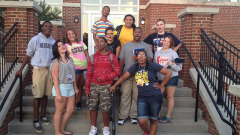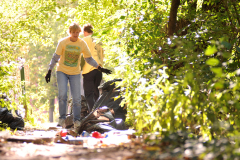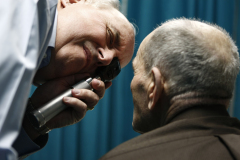Because of West Virginia University:
- Several thousand people in the state are managing their diabetes.
- Student journalists are capturing veterans’ stories through West Virginia’s Veterans History Project.
- Families are receiving legal help to secure their rights.
Through hours of time and streams of good will, West Virginia and the world beyond have experienced true change from this one University.
On Wednesday (Jan. 5), the Carnegie Foundation for the Advancement of Teaching recognized the scope and success of WVU’s impact by selecting the University for the 2010 Community Engagement Classification, putting WVU in the 6 percent of higher education institutions that Carnegie recognizes for engagement out of all U.S. institutions. It is the only institution in West Virginia the foundation recognizes for its community engagement.
“WVU’s level of outreach and service to our state is truly exceptional,” said WVU President Jim Clements. “From providing free dental care for those in need to building homes for underserved families, community engagement is the hallmark of our land-grant University.” He added, “I’ve often said that ‘no university means more to its state than WVU means to West Virginia,’ and I believe this classification underscores that belief.”
Dr. Brian Noland, chancellor of the West Virginia Higher Education Policy Commission, congratulated the University on its achievement.
Click below to go Inside WVU and hear more about the Carnegie award.
“This classification speaks volumes about West Virginia University’s commitment to the communities it touches – and thanks to the University’s extended efforts, those communities are increasingly vast,” Noland said. “The role of higher education goes far beyond the classroom, and I applaud WVU for its growing loyalty to this vitally important mission.”
To promote the University for the classification, Associate Provost for Undergraduate Academic Affairs Elizabeth Dooley and a committee made of up of various University employees came together this year at President Clements’ request and examined what WVU does for the community, how it does it, and what it does to measure its success.
The result was a nearly 40-page report that covers many aspects of the University’s service commitment.
-The NOVA Institute
-WV Statewide Student Business Plan Competition
-International Leadership Academy
-Clinical Law Programs
-Volunteer Income Tax Associates program
-WVU's National Research Center for Coal and Energy
-WE CAN Blue and Gold Mine Sale
-WVNano
-Coronary Artery Risk Detection in Appalachian Communities
-Multidisciplinary Unsheltered Homeless Relief Outreach in Morgantown
-Energy Express
-Dining with Diabetes
-Health Sciences and Technology Academy
-Continuing and Professional Education
-Forensic and Biometric Gateway
What stood out during the hours spent preparing the report for the foundation, Dooley said, is the culture of service at WVU prompted by the University’s land-grant mission.
“I think it’s the culture,” she said. “I really do. WVU has embraced a culture of service.”
This designation is a celebration of the University’s achievements, she added.
“What it does for West Virginia University is to showcase our impact on the lives of citizens of West Virginia,” she said. “I believe this is a designation that we’ve earned.”
WVU Provost Michele Wheatly agreed that the honor reflects WVU’s core mission.
“Earning this classification is deeply meaningful for WVU as it prepares to launch the 2020 Strategic Plan,” she said. “As stated in the fifth goal: to ‘Enhance the well-being and the quality of life of the people of West Virginia’ WVU takes its land-grant mission very seriously.”
Dooley noted that WVU’s community engagement is systemic and not isolated to a few colleges.
The impact comes in different sizes from different people, but under one name. The students, faculty and staff at WVU have found ways to use their knowledge to benefit the public through independent projects or one of the University’s main outreach efforts.
From 2008-2009, WVU used more than $21 million in its grants and awards toward public service and the Health Sciences Center provides $84 million in uncompensated care annually.

Behind these big-dollar examples are individuals who will have a better life because of the University’s outreach. In the Health Sciences and Technology Academy, one of the programs most descriptive of WVU’s mission, 1,300 students since 1998 have graduated from high school and 90 percent of those have graduated college. More than half have gone into science, technology, engineering and math fields.
“The Health Sciences Center was established to transform lives and eliminate the health disparities throughout West Virginia, especially in rural communities,” said HSC Chancellor Dr. Christopher C. Colenda. “This award is emblematic of our commitment to serve each and every West Virginian through exemplary health professions education, research and clinical care.”
Then there’s the creativity and cooperation used to solve pressing problems. The Business Incubator gets business owners on their feet. The College of Engineering and Mineral Resources trained almost 9,000 people in the mining industry in 2009 through extension. Continuing Education offers online training programs for emergency first responders in cooperation with the Department of Homeland Security. K-12 students throughout West Virginia are taught to prevent and are screened for heart disease through the WVU Department of Pediatrics’ CARDIAC program. WVNano established facilities for the use of researchers in nanoscale science engineering and education statewide.
Much of WVU’s outreach is coordinated through four key areas: WVU Extension, the Center for Civic Engagement, WVU Health Sciences Center and the WVU Research Corp.
Extension provides faculty agents in each of the 55 counties in West Virginia, and the Center for Civic Engagement coordinates service learning activities, placing more than 8,000 students annually into service learning opportunities.

“It’s really our privilege to serve the people of West Virginia in so many ways, every day – from transforming the lives of children through 4-H, to training firefighters, to helping individuals and families manage diabetes, ” said Dave Miller, associate provost and director of WVU Extension Service. “We’re humbled by this designation, and appreciate the recognition of our work as the on-the-ground, trusted University resource for the people of our state.”
Service is also a large part of the learning at WVU. In the 2009 academic year, 632 credit service-learning courses were offered in 58 percent of departments. Almost 5,000 students took service-learning courses.

“The Center for Civic Engagement is energized by the announcement that we achieved the Carnegie Community Engagement Classification,” said Kristi Wood-Turner, interim program director at the center. “On a daily basis, we have the opportunity to witness the commitment by students, faculty, and staff to the cooperative improvement of our community.
“We see this honor as validation and motivation for continued outreach and educational opportunities through community engagement.”
The Health Sciences Center offers many programs that benefit students and those in need of healthcare, an example being the West Virginia Rural Health Education Partnership, which places health professionals in community health centers around the state.

One of the research office’s examples of community outreach is the National Research Center for Coal and Energy, which advances innovations in the energy sector.
“The innovative work done by WVU researchers produces knowledge that helps create new products, new procedures, new jobs and new ideas that improve lives across West Virginia and across America – and improving lives is service to society in one of its most purest forms,” said Curt Peterson, WVU’s vice president for Research and Economic Development.
“At WVU, research is aimed at solving energy challenges, making advances in health care, reinforcing national security, keeping miners safe underground and much more. WVU research is productive, engaging and honorable service of which all West Virginians should be proud.”
Wheatly said the information compiled in the application for the Carnegie classification will help to formalize the way WVU assesses its community service and can lead to identifying future partnerships.
“In a state with such compelling disparities in educational attainment, health outcomes and economic prosperity, there is so much more that WVU can do, Wheatly said. “The timing of this notification only serves to reinforce our institutional commitment to the community and to strengthen and better integrate our efforts.”
By Diana Mazzella
University Relations/News
-WVU-
dm/01/05/11
Check http://wvutoday.wvu.edu/ daily for the latest news from the University.
Click here for a list of all institutions recognized for community engagement.
CONTACT: Elizabeth Dooley, associate provost for Academic Affairs
304-293-2641, Elizabeth.dooley@mail.wvu.edu